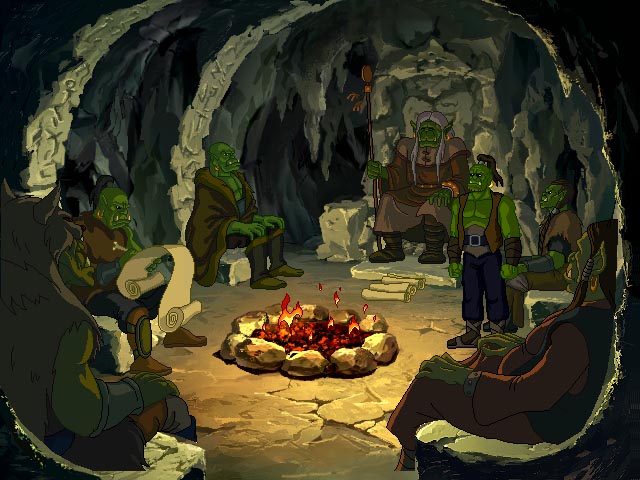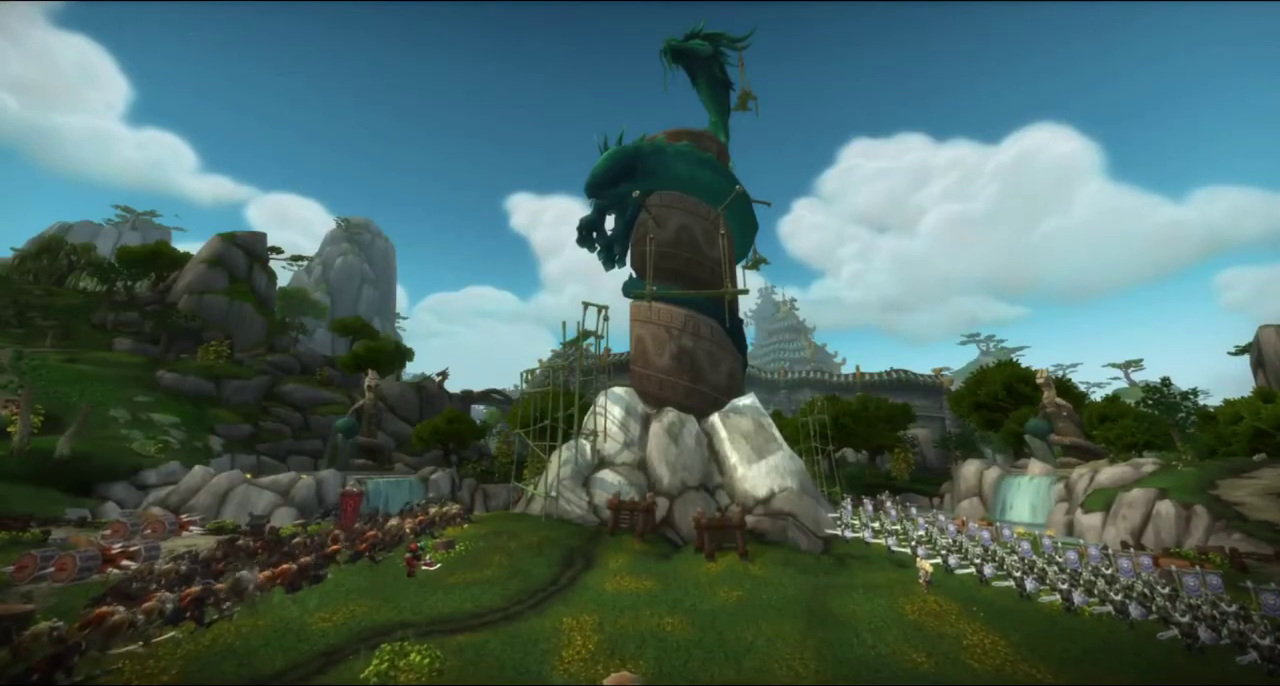Warcraft Retrospective 11: Interlude: Warfare vs Adventure

We’re now in the year 1996. After the commercial success of Warcraft 2 and its expansion, Blizzard began development of a point-and-click adventure game set in the Warcraft universe after the events of the two RTS games. In Warcraft Adventures: Lord of the Clans, the player will be controlling Thrall, a young orc raised as a gladiator slave by a human noble, as he escapes captivity and learns the truth about his heritage—
Wait, what?
How did we go from two military superpowers warring for control over a continent to the escapades of a single orc?
The out-of-universe answer is that Blizzard was getting tired of the real-time strategy genre at that time, and wanted to branch out into other genres. Capitol Multimedia, a sister company to Blizzard that owned the animation studio Animation Magic, suggested using the Warcraft license for a graphic adventure game, and Blizzard, looking to do more with its “orcs and humans” setting, agreed.
The change of story focus from armies and fortresses down to individuals began as early as Beyond the Dark Portal, which introduced a cast of recurring protagonists for each side. However, because of the limitations of Warcraft 2’s storytelling format, the characters were barely given any characterization at all. What do we really know about Grom Hellscream or Danath, as people, based on Beyond the Dark Portal alone? Not much. And it didn’t matter. They were just unique units to give some flavor to the real focus of that game, which was base building, army deployment and siege combat.
When Warcraft games zoomed in from big-picture continental warfare and changed their genre from strategy to adventure, this was not, by itself, a problem. However, Blizzard then decided to continue telling adventure stories in the Warcraft setting, which necessitated a gear shift so sudden and rapid that it nearly broke the gearbox.
The underlying problem is that inclination towards warfare or adventure stories is a property of settings, not the stories themselves. If you want to tell warfare stories, you construct your world one way. If you want to tell adventure stories, you do it another way. This is because the two kinds of stories have different…
Setting Buy-In

In his highly recommended essay “Why Batman Doesn’t Kill People”, Shamus Young examines the question: Why doesn’t Batman just kill the Joker? He comes to the conclusion that Batman’s no-killing code is “a mechanical necessity of his stories, and no amount of hand-waving or excuse-making can change it”. If he started killing criminals, even unrepentant mass murderers who have shown they can’t be contained by any prison, then the entire foundation of the world he exists in would unravel. The article thus introduces the concept of a bent world, a world whose very structure is affected by the needs of the story.
While there have been many divergent takes on the character over the decades of his existence, the archetypal Batman, the Batman that exists in the public consciousness, is a power fantasy, a “good with fists” character representing a specific type of wish fulfillment: an embodiment of Justice for criminals beyond the reach of the law. His rogues gallery, likewise, are not mere criminals, but rather embodiments of different archetypes of crime itself. Batman cannot kill, say, the Penguin, because then we’d lose an easily identifiable effigy for Al Capone style mob bosses whom nobody can put behind bars even though “everyone knows they’re guilty”. And Batman can never retire; his stories have to continue forever to inspire us.
And so the worldbuilding “bends” the setting to support the stories the authors want to tell. This goes beyond just characters and their convictions — it affects the world itself. Since there always has to be crime for Batman to fight, Gotham must perpetually remain a corrupt hellhole with crippled law enforcement, and can’t be fixed just by throwing the Wayne family’s wealth at it.
As another example, Shamus Young lists Stephenie Meyer’s Twilight books. No, there is no intrinsic reason why two hot1 guys, a near-immortal vampire and a near-immortal werewolf, would fight for the love of the same plain human girl without much personality. However, it makes out-of-story sense when you realize that her plainness and lack of personality are a feature, not a bug: Bella is an audience surrogate for the teenage girls reading the book. The world of Twilight is constructed for a particular wish fulfillment fantasy, which is “what if hot men loved you the way you are”.
And the problem with setting buy-in, with the bent premise of a story’s world, is that if you’re a fan of the genre, it can be invisible to you. As Young writes:
The problem with fiction designed to appeal to a particular fetish is that if it happens to be your fetish it doesn’t seem odd. You probably aren’t bothered by – and might not even notice – how bent the story is, because the world makes sense and you intuitively understand that if it were any other way, then it would no longer be catering to your entertainment needs. That’s fine, but it makes it kind of hard to look at it objectively.
The two examples just given belong to the superhero and young adult romance genres. Warfare and adventure stories generally also presume a certain setup each, and parts of that setup can come into conflict.
Warfare Worlds, Adventure Worlds

If you, as a fiction writer, want your world to support primarily warfare stories, a typical setup you will use will be along these lines:
- The world, or the galaxy in a space setting, is contested between powerful nations with legitimate grievances against each other.
- These nations are able to equip and deploy massive armies and fleets, indicating large populations and strong economies.
- Central governments are strong. They have to be, because they must actually be able to control conquered territories. Most problems in the world are addressed by government efforts, not by independent contractors. Alternatively, civilian governments might be relatively weak, but military commanders enjoy great power, which makes them as likely to stage coups against their supposed rulers as to actually engage the enemy.
- Borders are closely guarded, since the warring nations want to keep out enemy spies and saboteurs. Independent travelers roaming the world are likely to be viewed with suspicion by all sides.
- Technology is likely on the rise. Even if not an outright arms race, the effect of new types of guns, war machines, or spells on warfare can be a compelling plot hook.
- The protagonists are likely to be working for one of the warring nations — or perhaps they are on different sides, and that forms part of the drama of the story. Individuals, by themselves, cannot make a large impact on the world without being backed by at least one of the warring powerhouses.
If a warfare setting is meant for an ongoing series rather than a standalone work, it’s unlikely to ever see lasting peace, because that would destroy the core appeal and premise — the same way Batman can’t ever turn Gotham into a safe and functioning city and happily retire, because then his ongoing story would be over. In a warfare series, instead of stable peace, you’re likely to see armistices, cold wars, coups, revolutions, and superpowers and alliances breaking up and reforming — keeping the political map of the world constantly redrawn and preventing it from settling.
Examples of warfare settings would be Star Wars during the original trilogy, Ender’s Game, Warhammer 40,000, and Code Geass.
On the other hand, if your world is supposed to support mainly adventure stories, then there are likely to be different assumptions behind it:
- Much of the world is unexplored and unclaimed. It might be that the wilderness is infested with monsters, or there is simply no government that bothers to claim it.
- Individuals can make a meaningful difference working on their own, outside any formal chain of command.
- Central governments are small and weak, if they exist at all. After all, your stories focus on a small cast of adventurers, and if the government could just exterminate the wandering monsters or send its own archaeologists to study the ancient temple, there would be nothing for the protagonists left to do. A typical adventure world consists of isolated villages, city-states, and small feudal domains.
- As a corollary to the former, armies are small, armed conflicts are localized instead of spilling to the entire continent, and the more remote towns might be protected by nothing more than skeleton garrisons.
- If borders are maintained at all, they’re relatively transparent and adventurers are able to move from town to town with little problem.
- Multinational groups are more common. In fact, the main cast is likely to be multinational, so that the unique perspective of different cultures can be showcased through the protagonists alone.
- Technology levels are relatively stable, because there’s no centralized effort nor pressing need to improve them. In fact, technology and/or magic might even be in decline compared to the old days, and powerful artifacts are more likely to be ancient than brand new.
Unless the protagonists are solely concerned with their personal power or wealth, a typical adventure story usually leaves the world, country, or at least town a slightly better place than it was before. Once a specific problem is fixed, it tends to stay fixed, though there may be recurring villains.
Examples of adventure settings are Middle-earth during The Hobbit and The Lord of the Rings, Forgotten Realms, Xena: Warrior Princess, and to some extent Star Trek: The Original Series.2
It’s not always as clear-cut, of course. Rather, like with most loose classifications, it’s a continuum. The world of Avatar: The Last Airbender, for example, has many traits of an adventure setting despite taking place during a global war, with the protagonists — a multinational adventuring party — being driven by the goal to end said war. The episodes alternate between battles and adventures with Wacky Wayside Tribes that have no direct relevance to the main plot, and once the Fire Nation is defeated, the world turns into a pure adventure setting.
Implications for Warcraft
Is Warcraft a warfare setting, or is it an adventure setting?
…Um…
Just like the answer to the question “Does Blizzard make good games?” would be “which Blizzard?”, so would the right answer to the above question, in my opinion, be “which Warcraft?”
The world of Warcraft 1 and 2 is undoubtedly a warfare setting. In Beyond the Dark Portal, the human campaign is still a warfare story, but the orc campaign desperately wants to be an adventure story and is prevented from being one by the RTS format.
By the end of Tides of Darkness, the Horde is resoundingly defeated. By the end of Beyond the Dark Portal, it’s super resoundingly defeated, its home world blown up to smithereens, with the last free orcs having followed Ner’zhul to some other world with no entrenched power base, and the orcs in human lands captured and put in internment camps. There is no superpower left to oppose the Alliance in the known world, but the Alliance itself has been weakened and fractured by political disagreements.
We’re in a weird transitional state. There is no obvious casus belli to support further war stories, unless the writers contrive a reason for the different human, elven and dwarven kingdoms to fight each other. Instead of writing further war stories, in games or otherwise, Blizzard seems to have decided to retool Warcraft into an adventure setting.
Problem is, it’s not really ready to be one — not yet, at least. Though weakened, plundered, and driven apart, the kingdoms of the former Alliance are individually still strong, and Warcraft 2 has shown technology to be booming. Furthermore, there hasn’t been any indication that their lands are suffering from any particular problems that would warrant the attention of adventurers.
It’s too early to talk about Warcraft 3 yet, but in hindsight it can be seen as a story constructed to turn the warfare setting of Warcraft 2 into the adventure setting of vanilla World of Warcraft. And then, of course, the expansions completely muddled the picture, because it seems someone on the development team had an inexplicable fondness for Warcraft 2 and tried to repeat its beats in a game ill-suited for it — resulting in the nations in the game oscillating between “small city-states on the brink of collapse if not for adventurers” and “global powers popping armies out of nowhere and plastering their flags all over the planet”, depending on the writer.
What’s Next?
Next up, we’re going to look at the first game in the Warcraft setting that’s explicitly an adventure story, fittingly titled Warcraft Adventures: Lord of the Clans.
Or at least, we would, if the game was ever officially released. It was canceled despite being very nearly ready. Its broad strokes premise was adapted into a novel and formed important background lore for Warcraft 3, but many of the finer lore details were very different from modern Warcraft.
Since I don’t want to go into arguments over whether it’s ethical to play a leaked build of a game that was never officially released, I won’t be playing the game. Instead, I’ll compile whatever official pre-release materials and developer accounts I can find, and from them, piece together the game we could have had.
See you next time — on Thrall’s quest to redeem the Horde and rediscover its noble past that totally was planned by the writers all along!
Screenshot of Batman and the Joker from The Dark Knight (2008) by Christopher Nolan.
-
Or at least intended hot. ↩
-
Though the Enterprise is a Federation ship and the Federation is an actually functional government, it’s not the focus of the original series, which largely takes place on unexplored frontier worlds. The crew are more researchers and diplomats than fighters, and of course, for a nominal Starfleet officer, Kirk is a maverick captain who’s more likely to follow his conscience than his out-of-touch superiors and obstructive Starfleet regulations. ↩
Leave a Comment